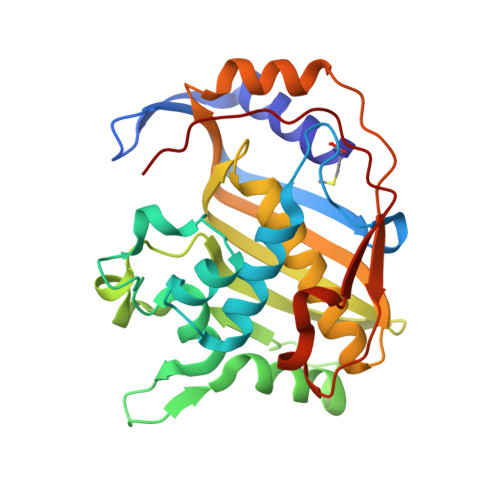The only active mutant of thymidylate synthase D169, a residue far from the site of methyl transfer, demonstrates the exquisite nature of enzyme specificity.
Birdsall, D.L., Finer-Moore, J., Stroud, R.M.(2003) Protein Eng 16: 229-240
- PubMed: 12702803
- DOI: https://doi.org/10.1093/proeng/gzg020
- Primary Citation of Related Structures:
1NCE - PubMed Abstract:
Cysteine is the only variant of D169, a cofactor-binding residue in thymidylate synthase, that shows in vivo activity. The 2.4 A crystal structure of Escherichia coli thymidylate synthase D169C in a complex with dUMP and the antifolate CB3717 shows it to be an asymmetric dimer, with only one active site covalently bonded to dUMP. At the active site with covalently bound substrate, C169 S gamma adopts the roles of both carboxyl oxygens of D169, making a 3.6 A S...H[bond]N hydrogen bond to 3-NH of CB3717 and a 3.4 A water-mediated hydrogen bond to H212. Analogous hydrogen bonds formed during the enzyme reaction are important for cofactor binding and are postulated to contribute to catalysis. The C169 side chain is likely to be ionized, making it a better hydrogen bond acceptor than a neutral sulfhydryl group. At the second active site, C169 S gamma makes a shorter (3 A) hydrogen bond to the 3-NH of CB3717, CB3717 is approximately 1.5 A out of its binding site and there is no covalent bond between dUMP and the catalytic cysteine. Changes to partitioning among productive and non-productive conformations of reaction intermediates may contribute as much, if not more, to the diminished activity of this mutant than reduced stabilization of transition states.
Organizational Affiliation:
Department of Biochemistry and Biophysics, University of California at San Francisco, San Francisco, CA 94143-0448, USA.

















